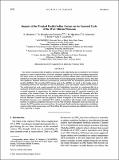Por favor, use este identificador para citar o enlazar a este item:
http://hdl.handle.net/10261/61213COMPARTIR / EXPORTAR:
 SHARE SHARE
 CORE
BASE CORE
BASE
|
|
| Visualizar otros formatos: MARC | Dublin Core | RDF | ORE | MODS | METS | DIDL | DATACITE | |

| Título: | Impacts of the Tropical Pacific/Indian Oceans on the Seasonal Cycle of the West African Monsoon |
Autor: | Mohino, Elsa; Rodríguez-Fonseca, Belén CSIC ORCID; Mechoso, Carlos R.; Gervois, S.; Chauvin, F. | Palabras clave: | Monsoons Rainfall Indian Ocean Teleconnections África Sea surface temperature Subsidence |
Fecha de publicación: | ago-2011 | Editor: | American Meteorological Society | Citación: | Mohino, E., B. Rodríguez-Fonseca, C. R. Mechoso, S. Gervois, P. Ruti, F. Chauvin, 2011: Impacts of the Tropical Pacific/Indian Oceans on the Seasonal Cycle of the West African Monsoon. Journal of Climate, 24, 3878–3891. doi: http://dx.doi.org/10.1175/2011JCLI3988.1 | Resumen: | The current consensus is that drought has developed in the Sahel during the second half of the twentieth century as a result of remote effects of oceanic anomalies amplified by local land–atmosphere interactions. This paper focuses on the impacts of oceanic anomalies upon West African climate and specifically aims to identify those from SST anomalies in the Pacific/Indian Oceans during spring and summer seasons, when they were significant. Idealized sensitivity experiments are performed with four atmospheric general circulation models (AGCMs). The prescribed SST patterns used in the AGCMs are based on the leading mode of covariability between SST anomalies over the Pacific/Indian Oceans and summer rainfall over West Africa. The results show that such oceanic anomalies in the Pacific/Indian Ocean lead to a northward shift of an anomalous dry belt from the Gulf of Guinea to the Sahel as the season advances. In the Sahel, the magnitude of rainfall anomalies is comparable to that obtained by other authors using SST anomalies confined to the proximity of the Atlantic Ocean. The mechanism connecting the Pacific/Indian SST anomalies with West African rainfall has a strong seasonal cycle. In spring (May and June), anomalous subsidence develops over both the Maritime Continent and the equatorial Atlantic in response to the enhanced equatorial heating. Precipitation increases over continental West Africa in association with stronger zonal convergence of moisture. In addition, precipitation decreases over the Gulf of Guinea. During the monsoon peak (July and August), the SST anomalies move westward over the equatorial Pacific and the two regions where subsidence occurred earlier in the seasons merge over West Africa. The monsoon weakens and rainfall decreases over the Sahel, especially in August. | URI: | http://hdl.handle.net/10261/61213 | DOI: | 10.1175/2011JCLI3988.1 |
| Aparece en las colecciones: | (IGEO) Artículos |
Ficheros en este ítem:
| Fichero | Descripción | Tamaño | Formato | |
|---|---|---|---|---|
| JC_2011_24_3878.pdf | 4,4 MB | Adobe PDF |  Visualizar/Abrir |
CORE Recommender
SCOPUSTM
Citations
44
checked on 21-abr-2024
WEB OF SCIENCETM
Citations
45
checked on 25-feb-2024
Page view(s)
358
checked on 24-abr-2024
Download(s)
405
checked on 24-abr-2024
Google ScholarTM
Check
Altmetric
Altmetric
NOTA: Los ítems de Digital.CSIC están protegidos por copyright, con todos los derechos reservados, a menos que se indique lo contrario.
